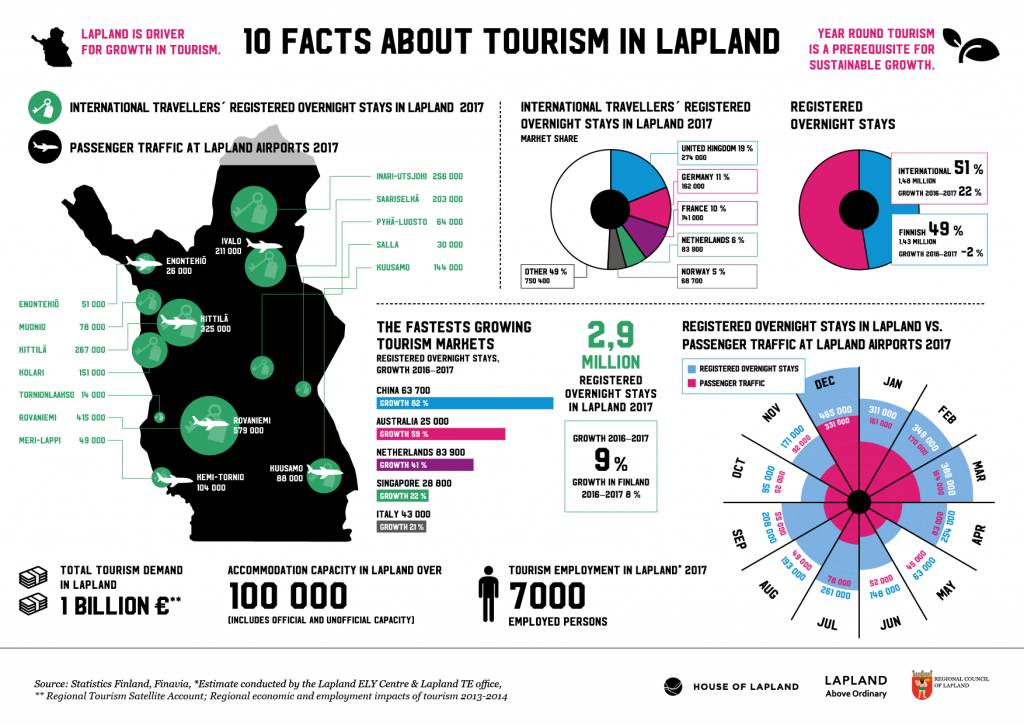Tourism industry in Lapland keeps on growing. Check out the infographic below for more details.

View a full-sized version 10 facts about tourism in Lapland 2018 of the infograph here.
Visit Lapland Material Bank for downloading infographics in pictures
Lapland as driver for tourism growth
The accommodation capacity, including official and unofficial capacity, in Lapland has exceeded 100,000, and all those beds were put to good use in 2017. Here’s a rundown of how many international overnight stays happened across Lapland:
- Enontekiö – 51,000
- Muonio – 78,000
- Kittilä – 267,000
- Kolari – 151,000
- Tornio Valley – 14,000
- Rovaniemi – 415,000
- Kemi – 104,000
- Kuusamo – 144,000
- Salla – 30,000
- Pyhä-Luosto – 64,000
- Saariselkä – 203,000
- Inari-Utsjoki – 256,000
From 2016, international overnight stays (1.48 million) grew 22%, overtaking domestic overnight stays (1.43 million).
In 2017, British travelers remained in the top spot, representing 19% of all international overnight stays. Here’s the rundown:
- UK, 19% – 274,000 overnight guests
- Germany, 11%, 162,000
- France, 10%, 141,000
- Netherlands, 83,900
- Norway, 5%, 68,700
- All others, 49%, 750,400
China topped the fastest growing markets, ranking 6th for overnight stays.
- China, 82% growth, 63,700 overnight guests
- Australia, 59%, 25,000
- Netherlands, 41%, 83,900
- Singapore, 22%, 28,800
- Italy, 21%, 43,000
Overall, there were 2.9 million overnight stays in Lapland in 2017, a 9% growth from 2016, and 1% more than Finland overall.
Passenger traffic through Lapland airports reflected the increase in international guests. Rovaniemi, being the largest airport in Lapland, naturally had the most traffic. Here’s the rundown:
- Rovaniemi, 579,000 passengers
- Kittilä, 325,000
- Ivalo, 211,000
- Kemi-Tornio, 104,000
- Kuusamo, 88,000
- Enontekiö, 26,000
Christmas and winter continue to be the largest draws to Lapland, with the month of December being the most popular, both in terms of overnight stays and passenger traffic. Here’s the numbers:
| Month | Overnight stays | Passenger traffic |
|---|---|---|
| January | 311,000 | 331,000 |
| February | 349,000 | 161,000 |
| March | 389,000 | 164,000 |
| April | 254,000 | 83,000 |
| May | 63,000 | 45,000 |
| June | 148,000 | 52,000 |
| July | 261,000 | 78,000 |
| August | 193,000 | 49,000 |
| September | 208,000 | 55,000 |
| October | 95,000 | 52,000 |
| November | 171,000 | 92,000 |
| December | 465,000 | 331,000 |
In all, the total tourism demand in Lapland reached 1 billion euros in 2017 and employed 7,000.


